
Willows, also called sallows and osiers, of the genus Salix, comprise around 350 species of typically deciduous trees and shrubs, found primarily on moist soils in cold and temperate regions.

Salix alba, the white willow, is a species of willow native to Europe and western and central Asia. The name derives from the white tone to the undersides of the leaves.

Salix caprea, known as goat willow, pussy willow or great sallow, is a common species of willow native to Europe and western and central Asia.

Salix × fragilis, with the common names crack willow and brittle willow, is a hybrid species of willow native to Europe and Western Asia. It is native to riparian habitats, usually found growing beside rivers and streams, and in marshes and water meadow channels. It is a hybrid between Salix euxina and Salix alba, and is very variable, with forms linking both parents.

A catkin or ament is a slim, cylindrical flower cluster, with inconspicuous or no petals, usually wind-pollinated (anemophilous) but sometimes insect-pollinated. They contain many, usually unisexual flowers, arranged closely along a central stem that is often drooping. They are found in many plant families, including Betulaceae, Fagaceae, Moraceae, and Salicaceae.

Salix amygdaloides, the almond leaf willow or peach leaf willow, is a species of willow native to central North America east of the Cascade Range. It can be found in southern Canada and the United States—from western British Columbia to Quebec, Idaho, Montana and Arizona to eastern Kentucky. As of 2022, it is presumed extirpated from the state of Kentucky.
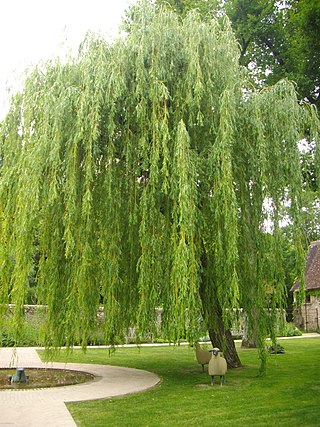
Salix babylonica is a species of willow native to dry areas of northern China, but cultivated for millennia elsewhere in Asia, being traded along the Silk Road to southwest Asia and Europe.

Salix polaris, the polar willow, is a species of willow with a circumpolar distribution in the high arctic tundra, extending north to the limits of land, and south of the Arctic in the mountains of Norway, the northern Ural Mountains, the northern Altay Mountains, Kamchatka, and British Columbia, Canada.
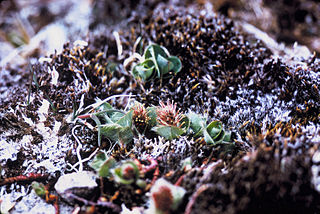
Salix arctica, the Arctic willow, is a tiny creeping willow. It is adapted to survive in Arctic conditions, specifically tundras.
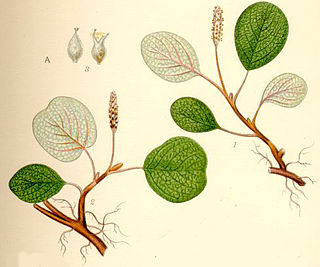
Salix reticulata, the net-leaved willow, or snow willow, is a dwarf willow, native to the colder parts of Europe, North America, and Northern Asia. It is found in the western United States, including the Sierra Nevada and Rocky Mountains. In Europe it extends south through the Carpathian Mountains and Alps to the Pyrenees and the mountains of Bulgaria and North Macedonia. It is common in Canada, Greenland and Finland, and present but rare in Scotland.

Salix lucida, the shining willow, Pacific willow, red willow, or whiplash willow, is a species of willow native to northern and western North America, occurring in wetland habitats. It is the largest willow found in British Columbia.
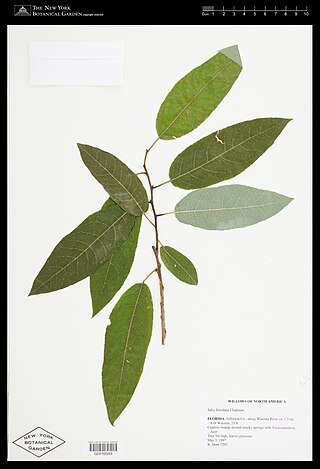
Salix floridana, the Florida willow, is a species of willow in the family Salicaceae. It is native to the southeastern United States in northern Florida and southwestern Georgia.

Salix acutifolia, also known as Siberian violet-willow, long-leaved violet willow or sharp-leaf willow, is a species of flowering plant in the family Salicaceae, native to Russia and eastern Asia. It is a spreading, deciduous shrub or tree, growing to 10 m (33 ft) tall by 12 m (39 ft) wide. The young shoots are deep purple with a white bloom. The leaves are narrow, up to 10 cm (4 in) long. The catkins are produced in early spring, before the leaves. Older bark has a fine, netted pattern.

Salix fuscescens is a species of flowering plant in the willow family known by the common name Alaska bog willow. It is native to northern North America, where it occurs throughout much of Alaska and across northern Canada. It is also present in Eurasia.
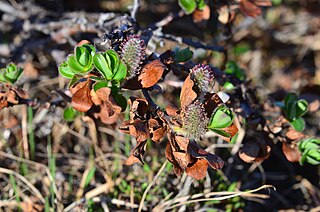
Salix pulchra is a species of flowering plant in the willow family, known by the common names diamondleaf willow, tealeaf willow, and thin red willow. It is native to northern North America, where it occurs in Alaska, Yukon, the Northwest Territories, and Nunavut. The species is also found in northern British Columbia, and occurs in Russia.

Salix richardsonii is a species of flowering plant in the Salicaceae, or willow family. It is known by the common names Richardson's willow and woolly willow. It is native to Russia and northern North America, where it occurs in Alaska and northern Canada. Some authorities consider it to be a subspecies, Salix lanata subsp. richardsonii(Hook.) A. K. Skvortsov rather than a species itself.

Salix eleagnos the bitter willow, olive willow, hoary willow, rosemary willow, or elaeagnus willow, is a species of flowering plant in the family Salicaceae, native to central and southern Europe and south west Asia. Growing to 3 m (10 ft) tall by 5 m (16 ft) broad, it is an erect bushy deciduous shrub with narrow grey-green leaves up to 20 cm (8 in) long, which turn yellow in autumn (fall). The green catkins, 3–6 cm (1–2 in) long, appear with the leaves in spring, male catkins having yellow anthers.

Salix daphnoides, the European violet willow, is a species of plant in the family Salicaceae. It can grow as a large shrub or small tree, normally reaching a height of 6–8 m (20–26 ft), but can grow up to 12 m (39 ft) tall.
Salix jejuna, the barrens willow, is a tiny willow restricted to a 30 km stretch of coastal barren lands of the Strait of Belle Isle on the Great Northern Peninsula of Newfoundland. It was first found in Labrador by Archibald Gowanlock Huntsman in 1923 and then by Merritt Lyndon Fernald, Karl McKay Wiegand, and Long in 1925. It grows in highly restricted limestone barrens where limestone crevices are found among thin soils that conceal fields of fissured limestone. It is characterized by small rounded leaves on short petioles growing close to the stems. The plant's growth architecture is twiggy flat mats that sprawl over the surface. Mats can extend to 30 cm in a couple of years. It flowers in late June to mid-July. Barrens willow's low-growing habit and spreading form allows it to take advantage of the sun-heated soil boundary and persist in harsh conditions including wind, wind-entrained ice, and soil frost heaving. Like all willows, it is a pioneer species.

Salix aegyptiaca, known as the Persian willow, is a large shrub or small tree from the genus of willow (Salix) with red branches that are tomentose in the first two years and leaves up to 15 centimeters long. The natural range of the species is in the Caucasus and in western Asia. It is cultivated in many countries.




















